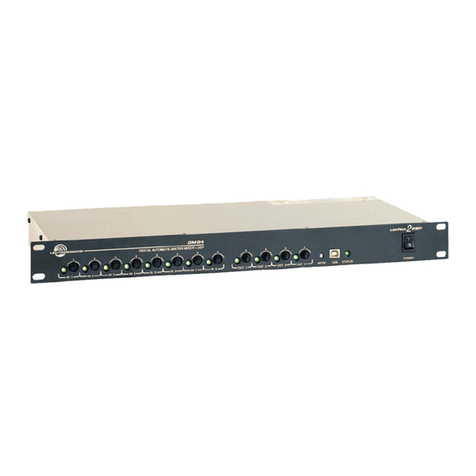
DM Series Installation Guide
LECTROSONICS, INC.
6
Installing the DM System into a Rack
The DM1624 and DM1612 occupy two rack spaces.
The DM812 occupies a single space. There are no spe-
cial ventilation requirements. Mount with 4 rack screws
using the appropriate mounting holes. It is recommend-
ed to use nylon washers to prevent damage to the front
panel’s finish when tightening the screws.
For North American installations, connect the Power
Cable supplied with the unit between the DM and a
stable power source. DM processors have internal
switching power supplies that can tolerate voltages
ranging from 100 VAC to 240 VAC. Use an approved
power cable for installations outside North America.
Cables
It is recommented to use lacing bars for cable strain
relief when mounting in a rack. Use only professional
audio cable with proper shielding - typically, two con-
ductor plus ground/shield.
Audio Connections
The analog audio inputs and outputs are connected
through 5 pin de-pluggable connectors. Strip the insu-
lation back 1/8 to 3/16” but do not tin (apply solder to)
the leads. Insert the wire into a de-pluggable connec-
tor, leaving less than 1 mm of bare wire exposed, then
tighten the retaining screw.
Caution: Do not over tighten the retaining
screw.
Note the labeling on the DM Chassis for the positive
and negative leads. Ground is shared between two
connections (the center pin). For balanced connec-
tions, all three leads can be connected.
NOTE: The DM Series does not have a “pin 1
problem.”
Audio Connection Guidelines
Unbalanced and balanced input connections use the
following guidelines.
Audio Inputs
Unbalanced Sources
Unbalanced audio sources (positive and ground)
include items such as consumer VCR’s, DVD play-
ers, etc., and may use both two wire and three wire
cables. In either case, the positive output from the
source should be connected to the appropriate positive
(+) input on the DM. The shield or negative (–) output
should be connected the DM’s negative (–) input. Two
wire cables should have a jumper between the DM
negative input and ground. Three wire cables should
have the shield connected to the DM’s ground input and
the shield and negative (–) leads joined together at the
unbalanced source end.
WARNING: Do not activate phantom power for
unbalanced sources. Refer to online help files
after the software is installed.
Balanced Sources
Balanced differential sources from external equipment
and microphones should be wired according to Bal-
anced source to DM input (3-Wire). (See illustration.)
When connecting balanced sources to the DM, it is im-
portant to not connect chassis ground (shield) to either
signal conductor.
Hardware Installation
DM In
+
-
Source
+
Unbalanced source to DM input
(2-Wire)
Shield
DM In
+
-
Source
+
Unbalanced source to DM input
(3-Wire)
Shield
5-pin depluggable
connector
Do not leave more than
1 mm of exposed wire
beyond the connector.
Do not tin (apply solder
to) leads
Retaining Screw
(Do not overtighten)




























